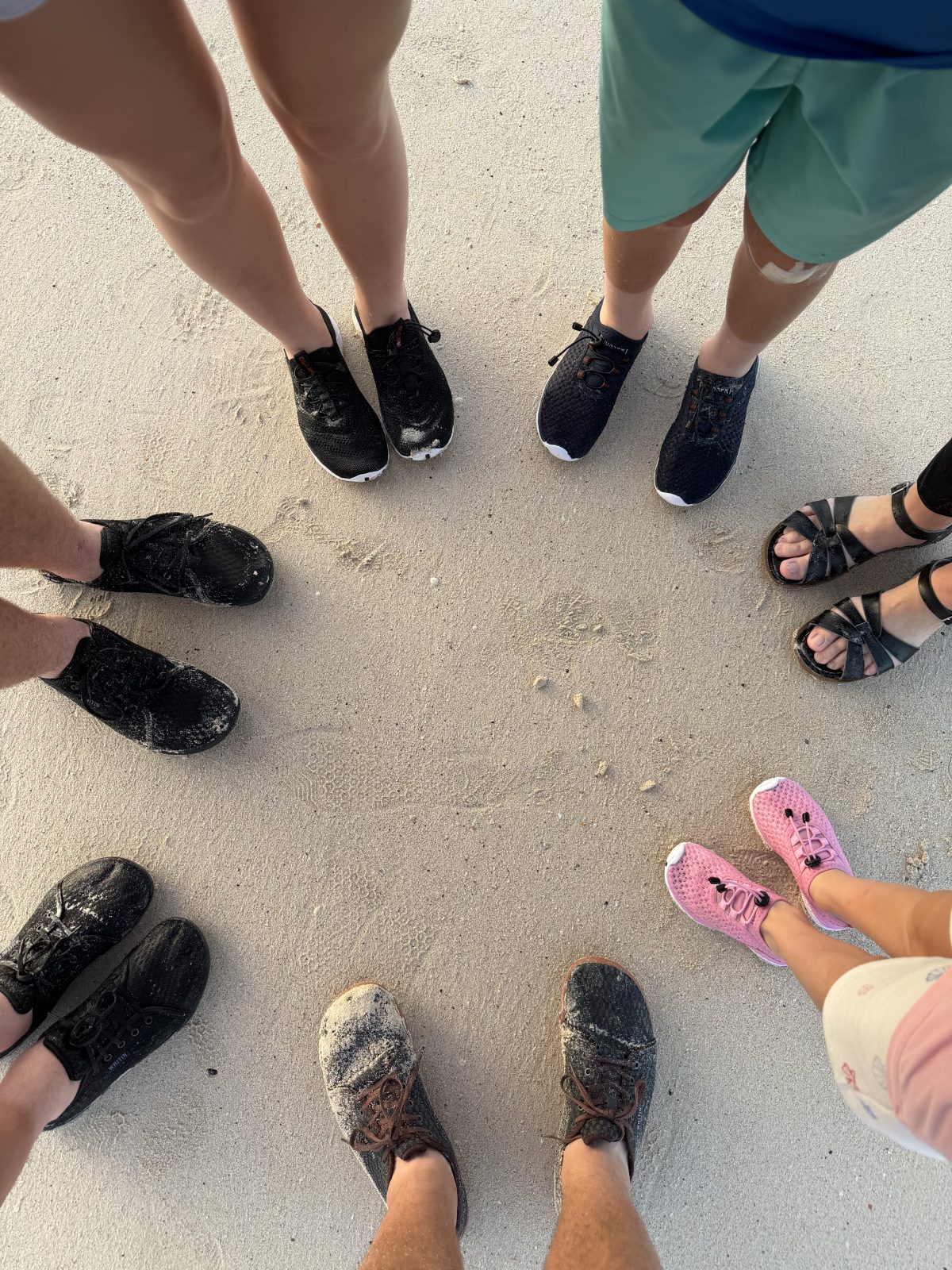Once again taking advantage of some calculated vacation bidding, the Evans Consortium has completed something never before done since our inception. We bought airline tickets. The privileges that come with working in the airline industry have availed us many opportunities to travel to all corners of the earth gambling on a slim chance that there’s a few first class seats open. Many times, our plans change, and we take moments maneuvering in uncomfortable airport seats playing cards while deducing what Plan B is going to be. And once we finally arrive at whatever our destination may be, the next challenge of securing lodging, transportation, and some sort of adventurous activities takes place. Not so much on this trip, because this time, there’s a boat to catch and it leaves with or without us.
Before heading into the ocean, we took to the capital city of Ecuador and explored the old historic part of town. Jaunts to the top of one of the many volcanoes that litter the landscape to enjoy some local delicacies brought us deep into a place we wish we could have stayed for hours. Watching the clouds move in mysterious ways, contouring with the sharp geologic formations left us in awe of the power of Mother Nature. After running out of time with the clouds, we arrived at the famous Mitad del Mundo monument. This tower, erected to celebrate the successes of the French Geodesic Mission of 1735, paints a bright yellow line running across the ground marking the equator, the invisible line that delineates the northern and southern hemispheres. Unfortunately, much like the Four Corners Monument, it is a few feet off of that which it represents. Later discoveries of the ellipsoid nature of our earth and the common acceptance of the WGS84 model of our planet put the actual equator a few hundred meters to the north. Or, so they say.
Nonetheless, as has been done in the past, the Evans Consortium stood together as we marked off the sixth continent visited as a family of seven. But as beautiful as the Andes mountains are, Quito was a mere side quest on our adventure to visit the Galápagos Islands.
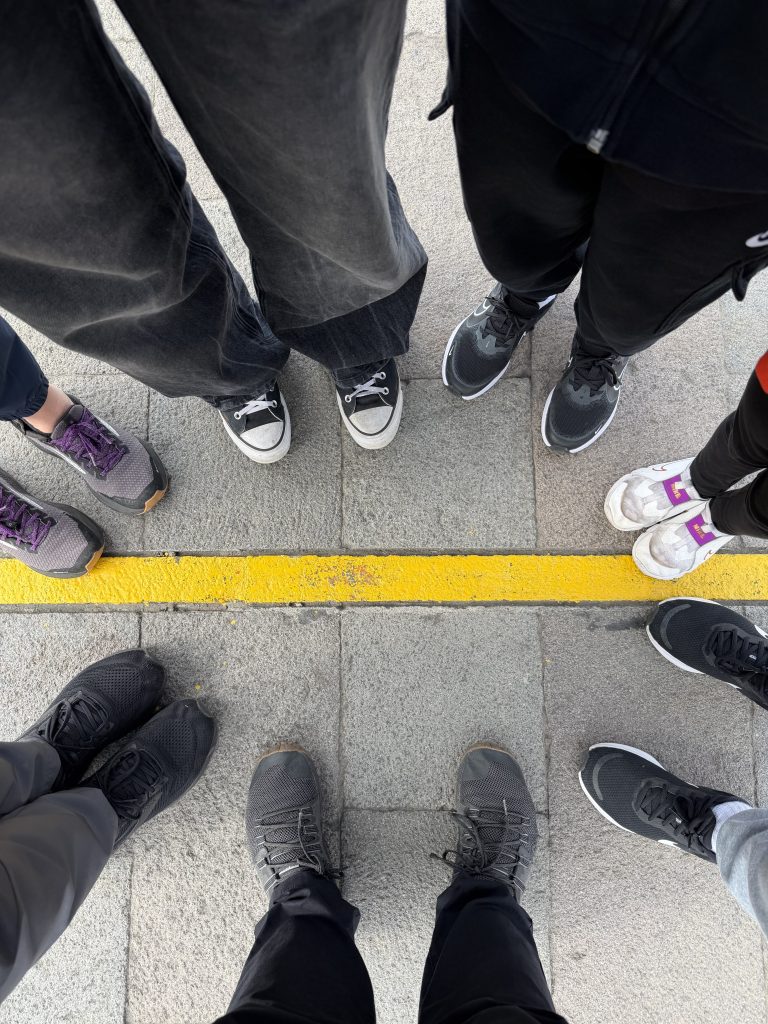
A few flights later, we arrived on Baltra Island, one of three airports located in the archipelago, but the one used mainly by flights to and from the mainland. A quaint little open-air terminal on what appeared to be an arid desert landscape of an island welcomed us to this beautiful place, and the naturalists that we would adventure with for the rest of the week ushered us towards our first of many “panga” rides. These rubber boats would become our stepping off points to visit these islands, sometimes being disembarked on a rudimentary boat dock, many times having to step off as the boat moves with the waves on the beach, and a few times just to plunge into the deep blue ocean.
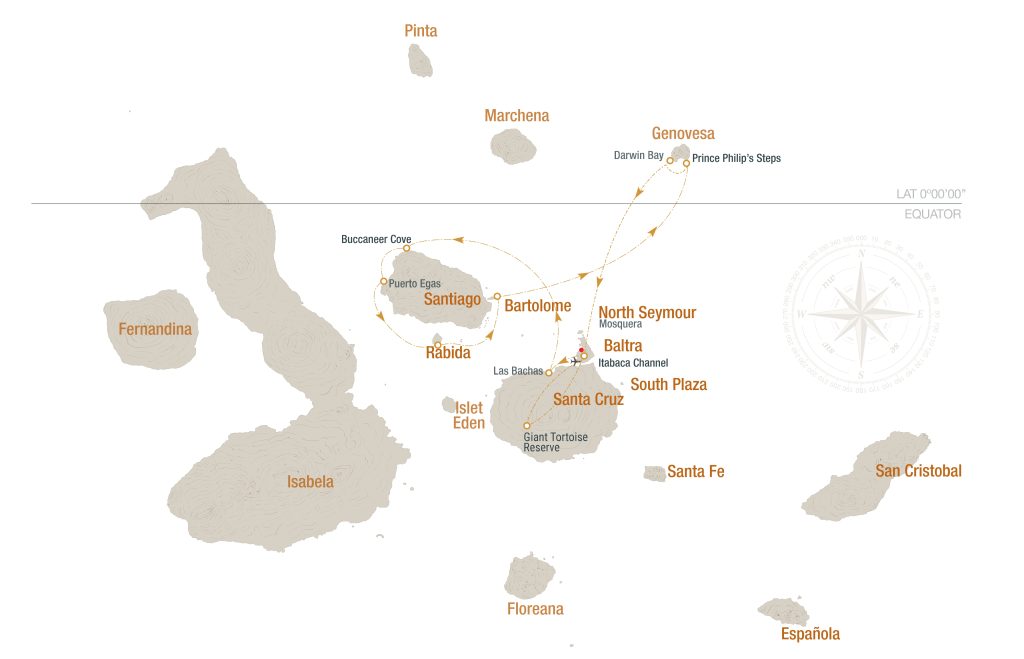
Leaving the once-fortified military establishments on Baltra, we set our course towards the MS Santa Cruz II, anchored nearby in deeper waters off the shore. The Santa Cruz II carries only 90 adventurers, and somewhere near 60 staff. While our ship wasn’t quite at capacity, never did we find ourselves crowded. Adventurers were divided into groups of ten, and having seven of us, plus Grandma, Grandpa, and Uncle Steven join along, the “Gulls” as we were called were whisked away for beach walks, shallow and deep water snorkeling, and hikes across six of the archipelago’s 18 major islands. One other group of travelers were from Germany, one or two were from the United Kingdom, and another were young Galapagueños who earned the privilege to sail with us as part of the expedition company’s outreach program. More on that later.
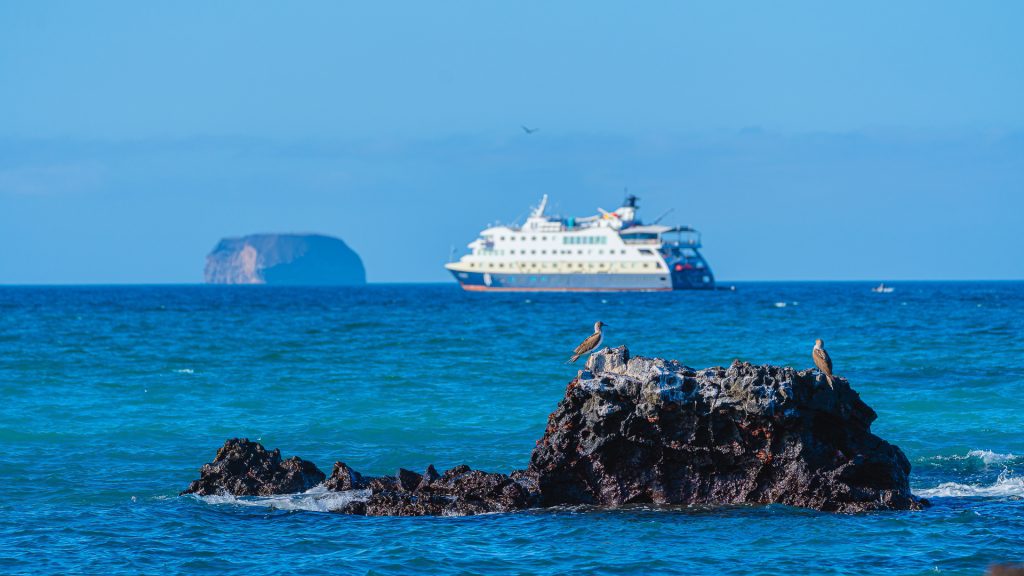
Binoculars at hand, our first landing was on the island of Santa Cruz, where white sands welcomed us to the tropics. Once fortified for receiving barges full of supplies, Playa las Bachas is now a quiet crescent beach on the north side of the island, serving as a refuge for many endemic and natural species. This afternoon, the clear blue skies permitted the observation of thirteen species of birds, nine of which I have never seen, and three that are endemic to the Galapagos (the lava gull as well as the small and medium ground finches). An interesting take on my observations, having never observed the American Flamingo in my travels, here I am in paradise seeing this bird in the wild for the first time. A few marine iguanas later, we retreated back to the ship with Adolfo, our naturalist and new friend, herding us Gulls back for supper to culminate our first day.
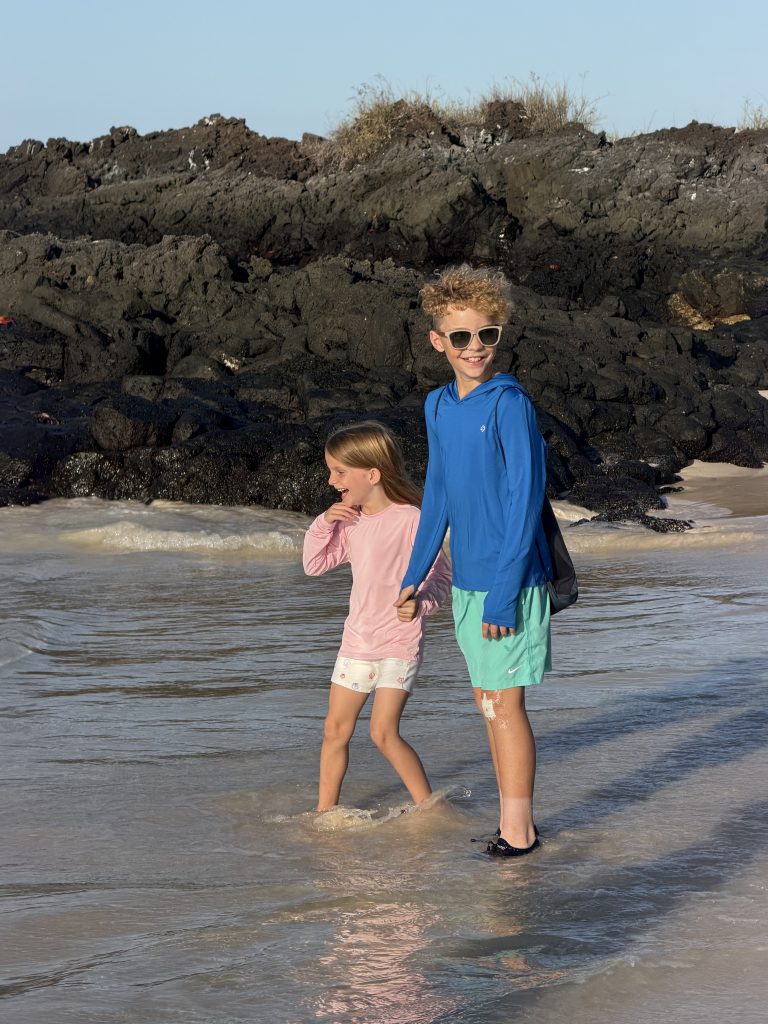
The following day, we set sail for Santiago Island, and specifically Buccaneer Cove. Named after the pirates that would seek shelter in this cove, a panga ride around these rocky shores added five more species to the life list, one of which was kind of a rare sighting. The Galapagos Hawk, the alpha predator of the archipelago, was spotted chasing a sea lion pup waddling towards its mother. Apparently they feast on the placentas of recently-born pups, but this one wasn’t quite that young. Hoping to see more wildlife, a quick panga ride back to the ship, a change of clothes, and we returned back to the cove to do our first bout of snorkeling. Adding a friend’s 360 camera to our arsenal, and the matching underwater case, we dove into the 68 degree water and peered into worlds unknown. Knowing that I wouldn’t be able to see everything, having to mind the flock of Evans kids bobbing around the 1-2 foot waves in the cove, I kept the camera underwater as much as possible, and only until the flight back home, reviewing some of the footage, while I was exchanging Oakli from riding my back to Stefani’s, a white-tipped reef shark swam behind us.
And if that wasn’t enough for day two, during lunchtime, the Captain set sail for Egas Port, our first black sand beach and first opportunity to accomplish a few things. Our first not-on-video observed shark encounter (another white tipped reef shark that kept close to the beach to welcome us to the water once again), and our second snorkeling experience where Matt lost a flipper to the ocean (the first was in the Caymans (sorry)). But more than just tempting the waves, we embarked on another stroll across these beautiful lands in search of more birds. Thirteen species observed, five more added to the life list, two endemic to the islands, the Galapagos Dove and Flycatcher. Thinking that was enough, we had the opportunity to stand on volcanic rocks that made some interesting formations such as Darwin’s Toilet (which sometimes resembles more of a bidet) that gave us a close-up opportunity to watch blue footed boobies fly in formation thirty feet above the water. Eventually, after flying in formation for a few moments, dinner would be spotted and in a coordinated effort, the squadron of boobies would dive into the underwater buffet only to repeat this a few more times. Much like the clouds in the volcano, I could have stood here for hours watching this performance.
With some free time back on the boat, one of the other adventurers informed me that the opportunity to visit the bridge is just a simple request away. Obviously more to satiate my desire to see how one commandeers a vessel such as the Santa Cruz II, we put in our request and moments later, took to the bridge, where one of the officers who was currently on watch showed us around the various controls of the ship. Relating the time-honored traditions of sailors in the past, he referenced the marks on the ship’s clock where radio silence must be honored in the event of emergency traffic (something that wasn’t around during the sinking of the Titanic, apparently). And for fun, he had the kids attempt to turn the backup wheel, the one directly connected to the rudder. Visiting the bridge and having these conversations with the officers of the ship had me even more excited for the multitudes of possibilities that this adventure would avail, so with a busy itinerary for the next day, we retired early as the next one would start early.
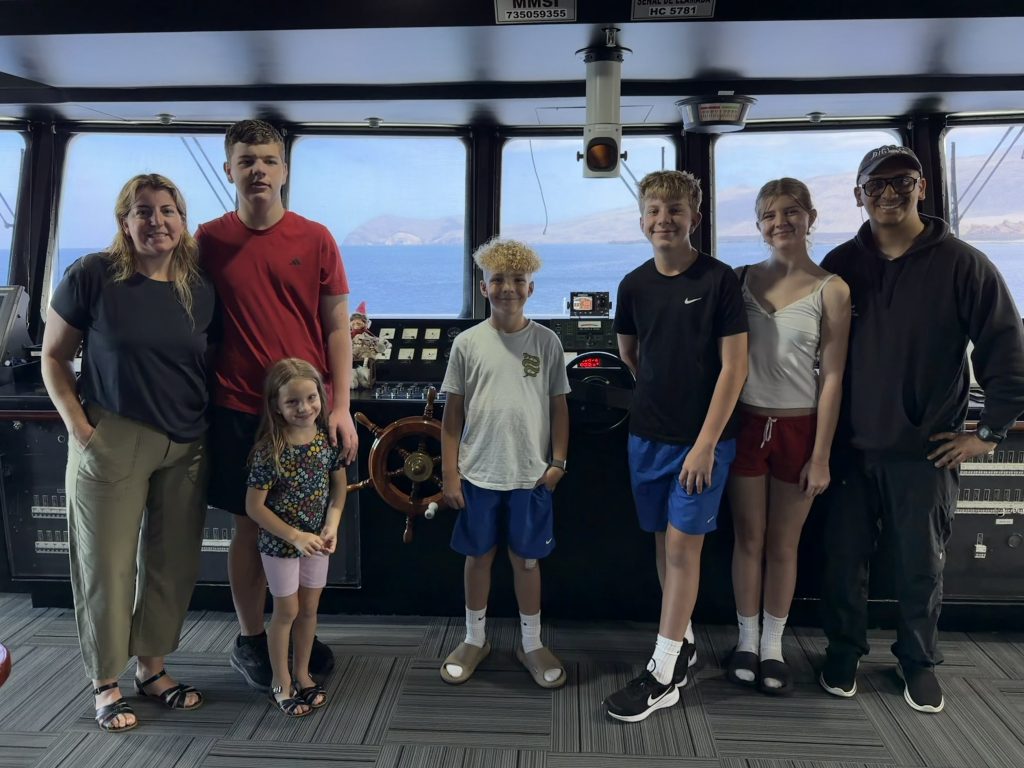
And that next day started real early. Waking before the sun, meaning we’d have to use an alarm clock (who does that on a vacation?), we once again took another panga ride to land on the red beaches of Rabida Island. Here we were supposed to have our first encounter with the flamingos, but as luck would have it, we saw them on day one visiting Santa Cruz. But on Rabida, we saw at least four fold more. Standing and walking towards us as they encroached upon our hiking trail boundaries, it appeared as though they were trying to communicate with us. Steven has some great footage that I’ll share here:
Rabida was also our opportunity to see more of Darwin’s finches, specifically the cactus finch. And in total, thirteen species were observed, three added to the life list, all of which were endemic species, including the cactus finch, the large ground-finch, and the Galapagos mockingbird. A few errant reads on a warbler or two were corrected by Adolfo, who, has such an amazing knowledge of everything in the Galapagos, from below the water to above the ground. His ability to take his depth of knowledge and bring it to a level that even our youngest can recall is something that will continue to inspire me in my quest to develop my passions.
Around Rabida Island the crew was divided again as a few opportunities were offered to us. Experienced snorkelers were taken a little further around the island to slowly make their way back towards the ship while enjoying the world beneath the water. Less-experienced snorkelers were taken to a small cove closer to the ship that ended up being a the place to be. Strong currents in the waters kept us experienced snorkelers from making any forward progress, and a brief ride in the panga brought us all together, only to find more sharks, stingrays, and starfish. What the experienced snorkelers did gain, however, is much more confidence in the water. Regularly, I’d find Luke and Kenzi diving deeper and deeper into the dark blue waters, pointing out the various underwater treasures that up until then have only been read about in books.
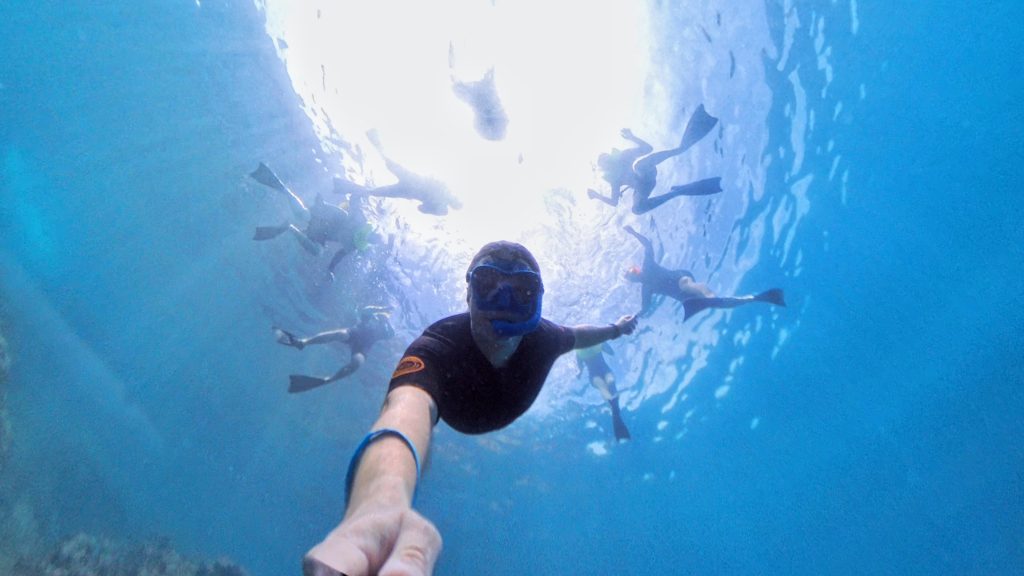
Speaking of educational experiences, each of our days was intermixed with some opportunities to learn more. From “Tiny Talks” about plankton, Charles Darwin, and even some activities for our younger adventurers (our children being the youngest by a large margin on the ship), there was always some learning to partake in. And certainly these opportunities aided in availing time for us to sail to yet another island on day three, the island of Bartolomé, named after a friend Darwin made on the HMS Beagle, Sir Bartholomew Sulivan. This island was supposed to be our first view of the Galapagos penguin, and lucky for us we for sure saw them, both on the land and in the water. Also spotted in the water was our first Galapagos green turtle, which at first was a difficult find due to the water conditions. Nothing a little closer inspection couldn’t help make more clear.
Before sailing away from the island at night, one last panga ride back to the island to hike to the highest point, a mere 357′ above the surface, gave us another perspective on the area around Pinnacle Rock that we had been enjoying previously. The stair-laden hike to the top revealed the monumental volcanic forces that made this island possible. Many spatter cones, colored in vibrant hues of red and brown littered the island, and the arid nature of the terrain left little for vegetation to grow. Seeds blown in the trade winds or the byproducts of birds brought few plants to the island, and those that call Bartolomé home either adapt to the lack of precipitation or wither away.
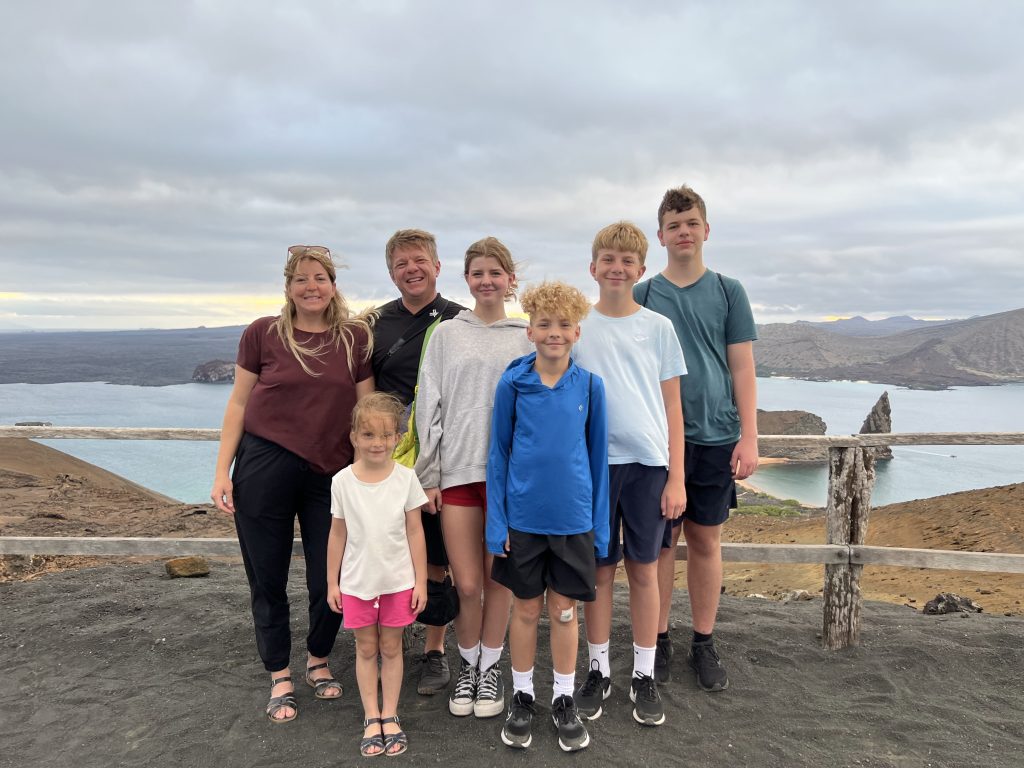
Earlier I mentioned the Expedition Company had a program where local Galapagueño youth get to come on the ship in an effort to not only help them learn more about the islands they call home, but the wildlife that they call their neighbors. This outreach program gains much support from a once-per-cruise charity auction, where unique items are sold to the highest bidder to raise the necessary funds to make these opportunities happen. And on our cruise, Oakli and I took a keen eye to an Ecuadorian flag that was flying off our stern for the week, and mustered up quite a bidding war, inevitably taking the highest bid while bringing home a unique keepsake with a purpose. While the opportunities for these young locals to join us are surely worth the effort, the gentlemen holding the microphone, playing the role of auctioneer this evening, was once one of those young adults who had earned the opportunity to join the expedition. Today, he’s part of the expedition team, helping share his love for this magical place with guests from all around the world.

The following day, we knew, was going to be our last day of adventures in the Galapagos. Setting sail for Genovesa Island all night, the most difficult anchoring awaited the crew of the Santa Cruz II. Because of the unique shape of the horseshoe island, a small break in the former caldera that once held Lake Arcturus out of the sea now allows for ships like ours to enter Darwin Bay. Because of the depths, however, there are limited areas for ships to drop anchor. A small (relative) rock near the northern part of the bay has space for two ships to park for the day, and on this island we were joined with the yacht La Pinta, another smaller expedition ship used by the touring company.

Genovesa Island is unique, in that in around 5 square miles of semi-flat lands atop this volcano resides over 2 million birds. Once we climbed the Prince Philip steps, we found the “Gulls” in the midst of a sea of nesting boobies. Nazca boobies, blue footed boobies, and the red footed boobies mean that we’ve crossed off seeing all the boobies prevalent in the Galapagos. Some with younger versions of themselves, whether in just hatched form, just gaining feathers form, or still in the confines of an egg form. And much like we’ve seen so far across the islands, they didn’t seem to mind our presence, tending to their young while we stare with wonder into their eyes. And, without having to pinch-zoom your phone pixels to oblivion, you could see with such great detail the beauty of these winged beasts.
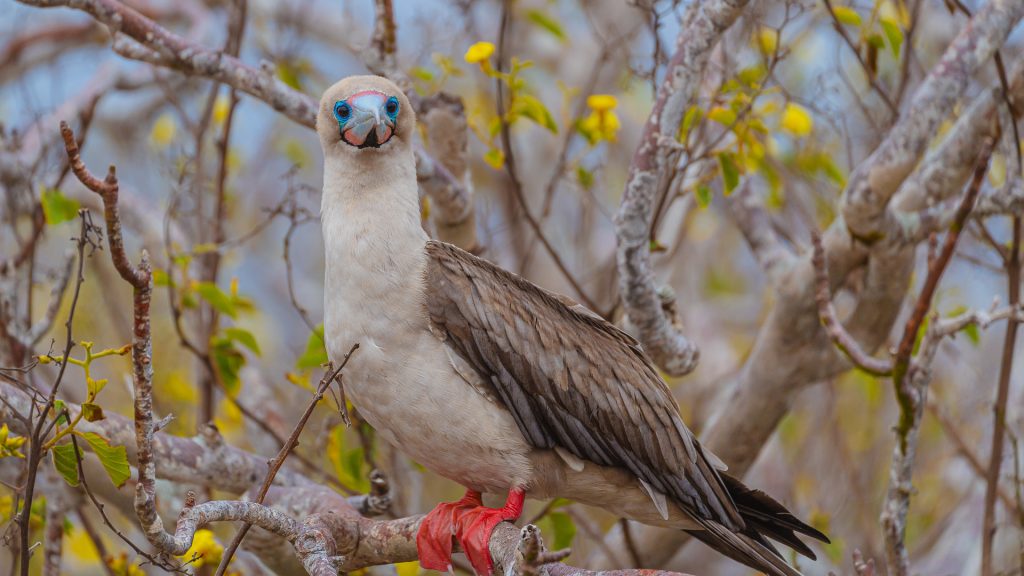
Later, on our last walkabout on the island, we found ourselves with front-row seats to some Nazca boobies giving gifts to one another. As part of their mating rituals, the male boobies will display their beaks high into the sky while raising their wings. Once they do their “high-stepping” dance to win the affection of their prospective mate, they will then start offering gifts to one another, in the hopes of sealing the deal. A few moments of scratching each other’s necks for a few moments, our naturalist Adolfo said, “I think they’re going to need some privacy here.”
As we returned to the boat one last time, we stared out at what was our floating home for the last week with hearts full of gratitude and minds still full of wonder. An amazing team of people keeping us well-fed, well-rested, well-equipped, and well-entertained were instrumental in making our Galapagos adventure as memorable as I could have imagined. A few toasts and cheers to the crew of the Santa Cruz II, many thanks were shared as one of the crew carefully put together pictures and videos from our week and shared them with us all. But most importantly, we said our goodbyes to our friend Adolfo, who for a week was an honorary member of the Evans Consortium, never batting an eye when I’d circle us all together for another picture.
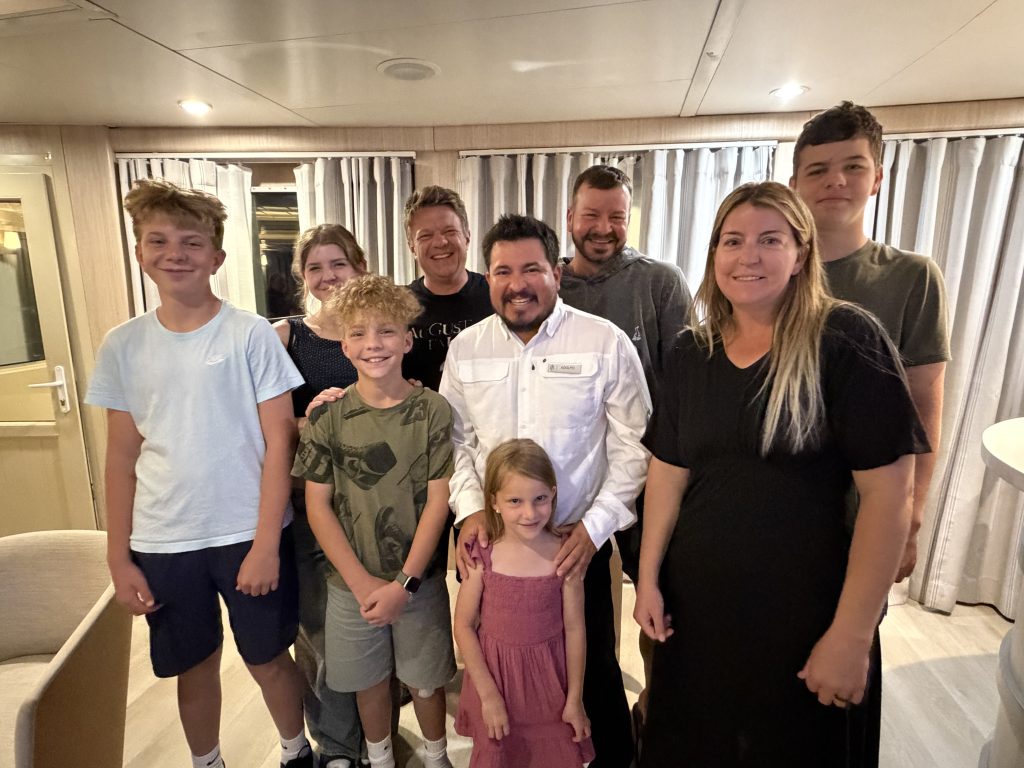
We spent a week in the Galápagos Islands staring into nature like never before. Deep beneath the crystal-blue waters, high atop the volcanoes that made these islands possible, we peered into the hearts of Mother Nature full of curiosity. And without batting an eye, Mother Nature welcomed us in with front row seats and a performance that I’ll never forget. And as awe inspiring as it was, having birds and beasts within arms reach, it was moments like the one below where I saw Mother Nature peer back at us with a similar curiosity. Some may come home from experiences like this and reduce their plastic consumption as to help make these experiences possible for future adventurers. Others may spend their resources to support efforts like the many conservation efforts that keep places like this pristine. And as much as we’ll do those things, I’ve got over 1,500 images and hours of video footage to help me relive these moments that I’ll truly treasure for a lifetime.
